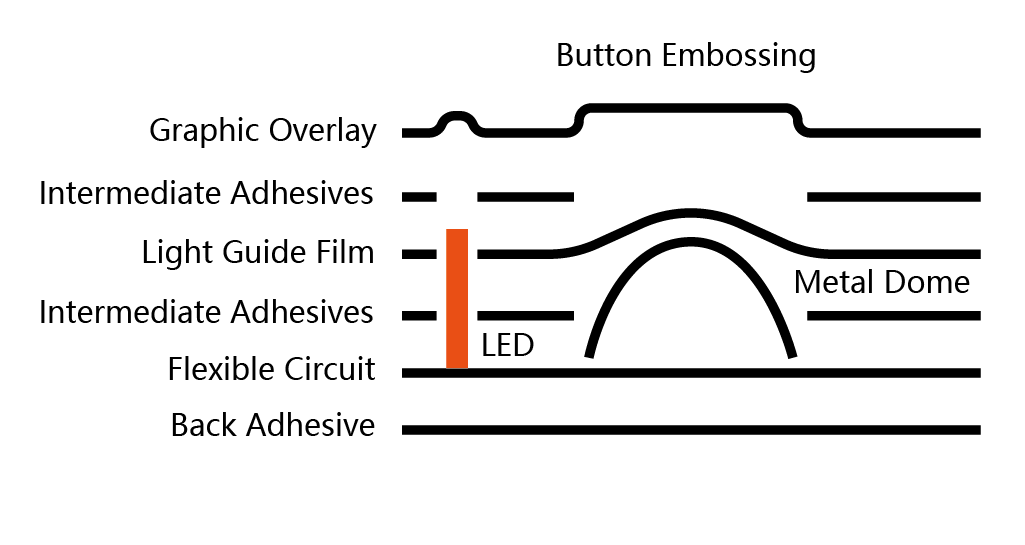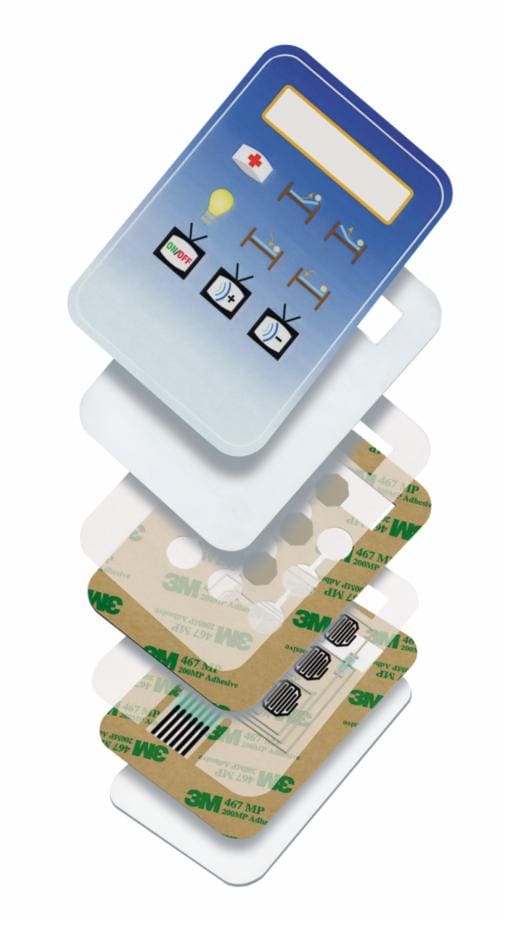Everything About Membrane layer Change: A Comprehensive Guide for Beginners
Membrane switches are vital parts in contemporary electronics, using an one-of-a-kind user interface for customer interaction - membrane switch. Their split construction, consisting of overlays and conductive traces, provides performance and toughness. Unlike standard mechanical buttons, membrane layer switches present a sleek layout and customizable choices. Comprehending their crucial attributes and benefits can transform product design. However, the complexities of their application and design considerations call for additional exploration
What Is a Membrane Switch over?
A membrane button is a type of electrical switch that includes an adaptable membrane layered over a printed circuit board. This layout permits a streamlined and portable interface, typically used in different digital devices. Membrane layer buttons are typically discovered in consumer home appliances, medical equipment, and commercial equipment as a result of their resilience and resistance to ecological factors.The building and construction commonly includes multiple layers, such as visuals overlays and adhesive backing, which provide tactile comments and protect the wiring beneath. The operation of a membrane switch is started when pressure is applied to the surface area, finishing an electric circuit.These buttons are valued for their convenience, enabling personalized styles and published graphics that deal with particular interface. Their inconspicuous nature minimizes area requirements, making them optimal for applications where traditional switches may not fit. In general, membrane layer buttons use a functional and visual solution for contemporary electronic gadgets.
Secret Components of Membrane Layer Switches
Membrane switches over comprise a number of vital elements that add to their functionality and efficiency. The leading layer, understood as the overlay, offers the user interface and is frequently published with symbols or graphics. Below the overlay exists a spacer layer, which separates the conductive elements and avoids unintentional activation. The next crucial part is the graphic layer, which boosts visual appeals and ensures the longevity of the design.Conductive traces, generally made from materials like silver or carbon, are printed on the circuit layer. When pressure is applied to the overlay, these traces enter get in touch with, completing the circuit. Furthermore, a backing layer offers structural assistance and can be made from products such as polyester or polycarbonate. With each other, these components create a dependable, easy to use user interface appropriate for numerous applications, from house devices to industrial devices. Understanding these aspects is essential for any individual thinking about membrane layer button modern technology.
Exactly How Membrane Layer Switches Job
Recognizing how membrane layer changes function is important for valuing their prevalent usage in numerous tools. A membrane button operates via a collection of layers, consisting of a graphic overlay, spacer, and a circuit layer. When stress is related to the overlay, it compresses the spacer layer, enabling the circuit layer to make get in touch with and complete an electric circuit. This activity sends a signal to the gadget, triggering a reaction, such as switching on a light or activating a function.Membrane switches over can be made with various attributes, consisting of tactile comments, backlighting, and custom graphics, boosting individual communication. Their building and construction enables a covered layout, securing the interior elements from dirt, wetness, and impurities. This toughness makes them ideal for varied applications, from consumer electronics to commercial equipment. In general, the simplicity and performance of membrane layer switches add to their appeal in modern technology.
Advantages of Membrane Layer Switches Mechanical Switches
While mechanical buttons have long been a staple in several gadgets, membrane layer changes deal distinctive advantages that make them progressively appealing. One significant advantage is their slim account, permitting for more compact layouts and higher versatility in item development. In addition, membrane changes attribute a consistent surface area, which boosts aesthetic allure and streamlines cleansing, making them appropriate for atmospheres where health is critical.Another benefit is their resistance to dirt and moisture. Unlike mechanical buttons, which can be compromised by ecological variables, membrane layer switches offer a closed user interface that safeguards versus pollutants - membrane switch. Membrane layer switches generally have a longer lifespan due to less moving parts, resulting in boosted sturdiness and reliability.Cost-effectiveness is likewise a noteworthy advantage, as membrane layer buttons can be created in bulk with reduced manufacturing expenses. These elements integrate to place membrane switches as a functional alternative to conventional mechanical alternatives in numerous applications
Common Applications of Membrane Layer Switches
Membrane layer buttons are extensively used in various markets, specifically in consumer electronic devices and commercial control board. In customer devices, they provide a streamlined, straightforward interface, while in industrial setups, they boost longevity and functionality. Recognizing these applications highlights the adaptability and functionality of membrane switches in modern technology.
Customer Electronic Devices Tools
As consumer electronics remain to progress, membrane layer switches have actually become a preferred selection for a selection of gadgets because of their versatility and smooth layout. These buttons are commonly found in smartphones, tablets, and push-button controls, where room is limited and aesthetics issue. Their reduced account and personalized styles permit producers to produce easy to use interfaces that enhance the general customer experience. In addition, membrane buttons are typically utilized in devices such as microwaves and coffee manufacturers, offering user-friendly control alternatives while withstanding dampness and dust. The toughness and dependability of membrane layer changes make them appropriate for daily customer products, making certain long life and consistent performance. Overall, their integration in consumer electronic devices shows a mix of performance and modern-day style.
Industrial Control Panels
The applications of membrane changes prolong past customer electronic devices, discovering significant usage in industrial control panels. These buttons are preferred for their longevity and resistance to harsh environments, making them suitable for making and process control settings. They offer a reputable interface for drivers to regulate equipment, monitor processes, and readjust settings. Membrane buttons can be personalized to fit specific operational requirements, incorporating features like backlighting and responsive responses, improving customer experience. Their low-profile layout enables integration right into various devices, while their ability to hold up against spills, dust, and extreme temperatures guarantees long life. In general, membrane layer buttons add to risk-free and effective operation in commercial applications, showing their flexibility and efficiency sought after atmospheres.
Considerations for Creating Membrane Layer Switches
When creating membrane switches, picking the ideal materials is important to assure durability and performance. Furthermore, understanding layer arrangement methods can greatly influence the button's efficiency and customer experience. These factors to consider play a vital duty in developing trusted and effective membrane layer button styles.
Product Choice Value
Product choice plays a vital function in the design and capability of membrane layer buttons. The chosen products directly affect the button's durability, tactile action, and overall aesthetic. Trick considerations include the substratum, which should provide architectural honesty while permitting adaptability, and the visuals overlay, which needs to be resistant to put on and ecological elements. Conductive products should ensure reputable electrical efficiency, while adhesives need to supply solid bonding click for info without jeopardizing the switch's operation. Furthermore, compatibility with producing processes and end-user environments is vital; products should stand up to differing temperature levels, humidity degrees, and chemical exposure. Inevitably, ideal material option not just boosts the membrane layer switch's efficiency however likewise adds to its longevity and individual contentment, making it a critical element of the design process.

Layer Setup Techniques

Often Asked Questions
The Length Of Time Do Membrane Switches Over Generally Last?
Membrane switches normally have a life-span of 1 to 5 million cycles, depending on use and environmental conditions. Factors such as layout high quality and operating frequency considerably influence their durability and general performance long life.

Can Membrane Changes Be Customized for Particular Designs?
Membrane layer switches can undoubtedly be personalized to suit particular styles, enabling diverse forms, colors, and capabilities. This convenience allows makers to tailor these buttons to meet unique visual and functional demands successfully.
What Products Are Made Use Of in Membrane Change Construction?
Membrane layer switches are generally constructed utilizing materials such as polyester, polycarbonate, and adhesive layers. These materials supply resistance, versatility, and toughness to environmental variables, guaranteeing the buttons operate properly in numerous applications and problems.
Are Membrane Switches Resistant or water resistant to Dampness?
Membrane buttons can be designed to be moisture-resistant, making use of specialized coverings and products. Their waterproof capacities depend on building and construction high quality and particular applications, making it crucial to evaluate demands for optimal efficiency in various environments.
How Are Membrane Changes Fixed if Harmed?
Repairing broken membrane switches over usually entails changing the affected layer or circuit. Specialists may also use conductive glue or use specialized repair work sets, making sure functionality is restored without full replacement of the entire button setting up. Unlike standard mechanical buttons, membrane buttons present a smooth style and adjustable alternatives. A membrane layer switch is a type of electrical button browse this site that is composed of a flexible membrane layered check my blog over a printed circuit board. The procedure of a membrane layer button is initiated when pressure is used to the surface area, finishing an electrical circuit.These switches are valued for their flexibility, allowing custom-made layouts and published graphics that cater to particular customer interfaces. While mechanical switches have long been a staple in several devices, membrane switches offer distinctive benefits that make them significantly appealing. Membrane switches typically have a longer life expectancy due to fewer moving components, resulting in enhanced longevity and reliability.Cost-effectiveness is likewise a notable benefit, as membrane layer switches can be produced in mass with reduced production prices.